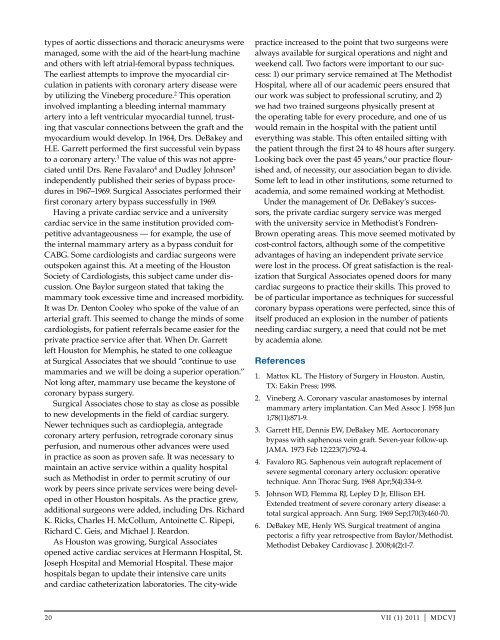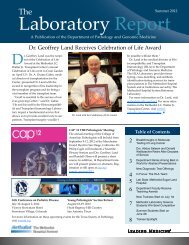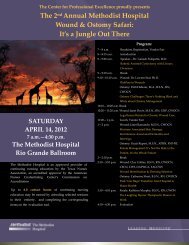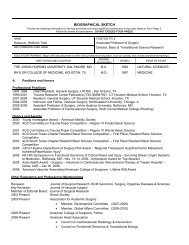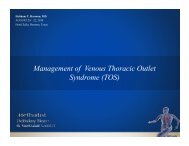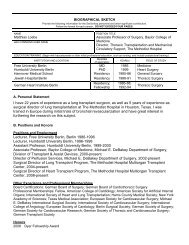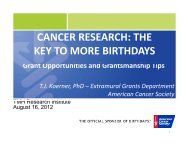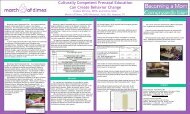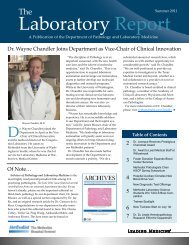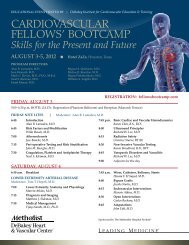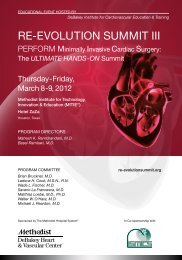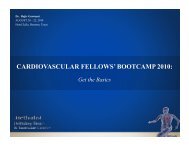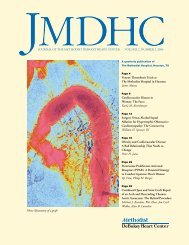DeBAKEy CARDIOvASCuLAR JOuRNAL - Methodist Hospital
DeBAKEy CARDIOvASCuLAR JOuRNAL - Methodist Hospital
DeBAKEy CARDIOvASCuLAR JOuRNAL - Methodist Hospital
You also want an ePaper? Increase the reach of your titles
YUMPU automatically turns print PDFs into web optimized ePapers that Google loves.
types of aortic dissections and thoracic aneurysms were<br />
managed, some with the aid of the heart-lung machine<br />
and others with left atrial-femoral bypass techniques.<br />
The earliest attempts to improve the myocardial circulation<br />
in patients with coronary artery disease were<br />
by utilizing the vineberg procedure. 2 This operation<br />
involved implanting a bleeding internal mammary<br />
artery into a left ventricular myocardial tunnel, trusting<br />
that vascular connections between the graft and the<br />
myocardium would develop. In 1964, Drs. DeBakey and<br />
H.E. Garrett performed the first successful vein bypass<br />
to a coronary artery. 3 The value of this was not appreciated<br />
until Drs. Rene Favalaro 4 and Dudley Johnson 5<br />
independently published their series of bypass procedures<br />
in 1967–1969. Surgical Associates performed their<br />
first coronary artery bypass successfully in 1969.<br />
Having a private cardiac service and a university<br />
cardiac service in the same institution provided competitive<br />
advantageousness — for example, the use of<br />
the internal mammary artery as a bypass conduit for<br />
CABG. Some cardiologists and cardiac surgeons were<br />
outspoken against this. At a meeting of the Houston<br />
Society of Cardiologists, this subject came under discussion.<br />
One Baylor surgeon stated that taking the<br />
mammary took excessive time and increased morbidity.<br />
It was Dr. Denton Cooley who spoke of the value of an<br />
arterial graft. This seemed to change the minds of some<br />
cardiologists, for patient referrals became easier for the<br />
private practice service after that. When Dr. Garrett<br />
left Houston for Memphis, he stated to one colleague<br />
at Surgical Associates that we should “continue to use<br />
mammaries and we will be doing a superior operation.”<br />
Not long after, mammary use became the keystone of<br />
coronary bypass surgery.<br />
Surgical Associates chose to stay as close as possible<br />
to new developments in the field of cardiac surgery.<br />
Newer techniques such as cardioplegia, antegrade<br />
coronary artery perfusion, retrograde coronary sinus<br />
perfusion, and numerous other advances were used<br />
in practice as soon as proven safe. It was necessary to<br />
maintain an active service within a quality hospital<br />
such as <strong>Methodist</strong> in order to permit scrutiny of our<br />
work by peers since private services were being developed<br />
in other Houston hospitals. As the practice grew,<br />
additional surgeons were added, including Drs. Richard<br />
K. Ricks, Charles H. McCollum, Antoinette C. Ripepi,<br />
Richard C. Geis, and Michael J. Reardon.<br />
As Houston was growing, Surgical Associates<br />
opened active cardiac services at Hermann <strong>Hospital</strong>, St.<br />
Joseph <strong>Hospital</strong> and Memorial <strong>Hospital</strong>. These major<br />
hospitals began to update their intensive care units<br />
and cardiac catheterization laboratories. The city-wide<br />
practice increased to the point that two surgeons were<br />
always available for surgical operations and night and<br />
weekend call. Two factors were important to our success:<br />
1) our primary service remained at The <strong>Methodist</strong><br />
<strong>Hospital</strong>, where all of our academic peers ensured that<br />
our work was subject to professional scrutiny, and 2)<br />
we had two trained surgeons physically present at<br />
the operating table for every procedure, and one of us<br />
would remain in the hospital with the patient until<br />
everything was stable. This often entailed sitting with<br />
the patient through the first 24 to 48 hours after surgery.<br />
Looking back over the past 45 years, 6 our practice flourished<br />
and, of necessity, our association began to divide.<br />
Some left to lead in other institutions, some returned to<br />
academia, and some remained working at <strong>Methodist</strong>.<br />
under the management of Dr. DeBakey’s successors,<br />
the private cardiac surgery service was merged<br />
with the university service in <strong>Methodist</strong>’s Fondren-<br />
Brown operating areas. This move seemed motivated by<br />
cost-control factors, although some of the competitive<br />
advantages of having an independent private service<br />
were lost in the process. Of great satisfaction is the realization<br />
that Surgical Associates opened doors for many<br />
cardiac surgeons to practice their skills. This proved to<br />
be of particular importance as techniques for successful<br />
coronary bypass operations were perfected, since this of<br />
itself produced an explosion in the number of patients<br />
needing cardiac surgery, a need that could not be met<br />
by academia alone.<br />
References<br />
1. Mattox KL. The History of Surgery in Houston. Austin,<br />
TX: Eakin Press; 1998.<br />
2. vineberg A. Coronary vascular anastomoses by internal<br />
mammary artery implantation. Can Med Assoc J. 1958 Jun<br />
1;78(11):871-9.<br />
3. Garrett HE, Dennis EW, DeBakey ME. Aortocoronary<br />
bypass with saphenous vein graft. Seven-year follow-up.<br />
JAMA. 1973 Feb 12;223(7):792-4.<br />
4. Favaloro RG. Saphenous vein autograft replacement of<br />
severe segmental coronary artery occlusion: operative<br />
technique. Ann Thorac Surg. 1968 Apr;5(4):334-9.<br />
5. Johnson WD, Flemma RJ, Lepley D Jr, Ellison EH.<br />
Extended treatment of severe coronary artery disease: a<br />
total surgical approach. Ann Surg. 1969 Sep;170(3):460-70.<br />
6. DeBakey ME, Henly WS. Surgical treatment of angina<br />
pectoris: a fifty year retrospective from Baylor/<strong>Methodist</strong>.<br />
<strong>Methodist</strong> Debakey Cardiovasc J. 2008;4(2):1-7.<br />
20 vII (1) 2011 | MDCvJ


